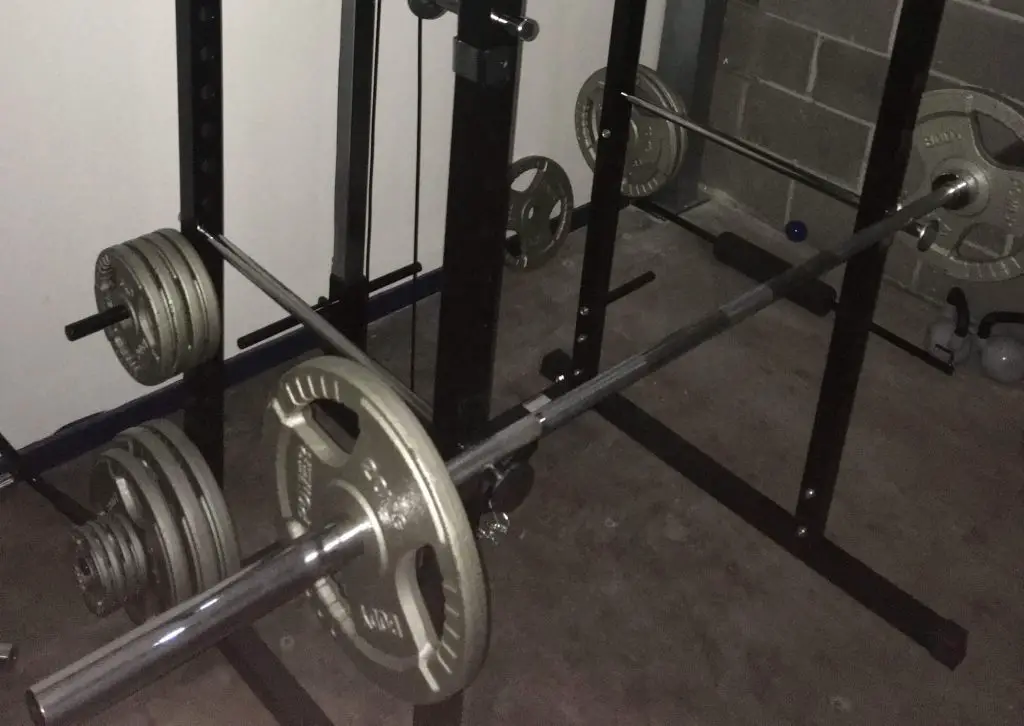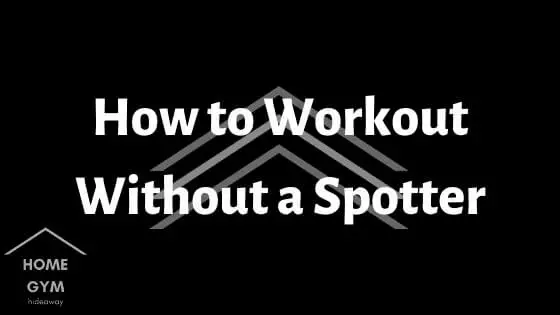Spotters are an important part of weightlifting for most people. If you want to increase your strength and muscle mass, you need to push your limits and lift weights close to your maximum capacity. When doing this, however, you run the risk of failing a rep and potentially injuring yourself.
Spotters help to prevent this.
For solo trainers or those training in a home or garage gym, however, having a spotter might not be an option. You’re therefore stuck in a position where you don’t want to push yourself for fear of injury through a failed rep but this doesn’t need to be the case.
Read on to see how to workout without a spotter, both from a safety perspective but also in a way that maintains performance and results.
Is It Ok to Workout Without a Spotter
Exercising for the most part is a relatively individual activity. This is the case even more so when it comes to lifting weights.
Many people use the weight room as a form of meditation and alone time. You can be surrounded by people but when you’re lifting weights, the only thing your mind is focused on is shifting the weight from point A to point B.
Having work or social commitments and a different schedule to that of friends and family means that it’s also difficult to get a consistent training partner to go to the gym with.
One person will always be more dedicated than the other and while I’ve had my fair share of training partners over the years, I’ve never gone with the same person for more than a few sessions per week.
This means that not only is it OK to workout without a spotter but it’s the default option for the majority of people.
It’s usually not an issue either as you’ll find people working out are doing it to work on themselves so have no issue just getting into the zone and training. The issue arises when you start to get stronger and use weights that could potentially cause you injury if you fail a rep or have an accident.
This is why spotters are used for big lifts so if you don’t have this as an option, we’ve covered some of the things you can do to workout without a spotter.
7 Tips for How to Workout Without a Spotter
1. Do Exercises That Don’t Require a Spotter
The easiest way to eliminate the requirement for a spotter is to do exercises that don’t need a spotter.
There are plenty of exercises that allow you to engage a muscle (or muscle groups) and these can be done safely. I’m not just talking about machine work either which I’ll come onto later but compound, muscle-building exercises.
Some of which include the front squat, dumbbell lunge, pull-ups, and even a deadlift. For a full list, check out our guide on the exercises which don’t need a spotter
2. Use Dumbbells
A barbell is something that’s very difficult to escape out from underneath if you end up getting stuck and failing a rep. There are some exercises like the squat, bench press, and overhead press where losing control of a rep could result in serious injury.
There are strategies to reduce this risk and some techniques you can use if you do get stuck failing one of these lifts. For more detail, check out our explanations in the articles below:
While barbell movements are considered essential by most people, there are plenty of exercises where you can substitute the barbell and instead use dumbbells. We’d say this is best for any pressing movements as you arguably get better muscle activation from the increased range of motion and you can also work up to heavy weights.
Using dumbbells means you can drop them to either side if you are failing a rep and can keep falling weights away from your vital organs as well. I remember getting stuck under a barbell when I was younger as I’d miscalculated the weight on the bar quite significantly so playing it safe with dumbbells is definitely ideal for the solo lifter!
3. Progress Without Increasing the Weight
There are many forms of increasing strength and muscle mass. One of the most accepted methods is progressive overload. Progressive overload means continuously pushing your body to do more than a previous workout. This is to force adaptation over time and to grow.
The type of progressive overload that most people are familiar with is adding weight to the bar.
If you keep getting stronger and lifting heavier weights, you’ll keep growing. As a general principle to follow, most people will see significant progress with their physiques if they are able to keep adding weight to their lifts on a consistent basis.
Where most people go wrong however is that this is the only form of progressive overload they do and this can be risky if you train without a spotter. The human muscle doesn’t just respond to heavier weight in order to grow, there are actually other types of progressive overload that are more joint-friendly and also safer when training solo.
Other types of progressive overload include:
- More reps
- Shorter rest periods
- More sets
- More time under tension
- Increased training density (a combination of the above)
A good example of this when training solo could be the squat. If you max out a 3 x 10 set, you don’t need to automatically increase the weight with your next session. Instead, look to add another set, do more reps, or have a shorter rest period.
All of these will stimulate and challenge the muscle groups in a way that will create muscle hypertrophy but you’ll be able to do this without constantly adding weight to the bar.
4. Use Safety Pins

A quick win for training solo is to use safety pins on your rack. There are different types which include spotter arms, safety straps, or spotter pins but all essentially provide the same purpose and that is to hold the barbell should you fail a lift.
These are connected to a power rack or squat rack and used to drop a barbell on should you fail a lift. Their sole function is to act as a mechanical spotter so that you can lift safely in a power rack. If you train at home and do so without a spotter then this is something you should use regardless of the exercise you’re doing.
They are not obtrusive and give you peace of mind that should you fail a lift, they will be more than an adequate safety feature.
5. Don’t Train to Failure
Training to failure is not essential for muscle growth or strength progression. Elite level powerlifters and strength athletes will only test a rep max a few times per year as a strength test or in the lead up to a competition.
Similarly, bodybuilders will train to failure in order to exhaust muscle fibers but they won’t do this on exercises like heavy compound lifts. Training to failure is reserved for isolation work or machine work (though some will do other exercises provided they have a spotter).
Many beginners however will train to failure on heavy compound lifts which drastically increases your risk of injury, especially if training alone!
An effective way to train safely when you don’t have a spotter is to avoid going to failure. You’ll find plenty of resources that say training to failure is not essential or even necessary for strength and muscle progression and it’s definitely a risk you can avoid when training alone.
If you do want to train to failure, do it on low-risk isolation exercises or machines. This way, when you reach failure you won’t be at risk and can do so safely.
6. Use Machines Instead of Free Weights
If you really don’t trust yourself training without a spotter, a quick win could be to use more machines. Machines a mostly designed to keep the user safe (while still working the target muscle groups) and due to the fixed movement patterns, you don’t need to make use of stabilizing muscle groups.
When you sit down at most machines, the weight stack, and fixed movement pattern already determine your movement. Take a lying chest press machine. The bottom position when you start the movement is the end range of motion.
If you fail a rep, the machine will just stop at the bottom position and as the handles are positioned out to the side, you can’t get stuck under a weight like you could with a barbell bench press.
Machines don’t have all the benefits of free weight training and while they do still have their place in most training routines, using them over free weight exercises would mainly be beneficial from a safety perspective for anyone training alone.
7. Be Prepared for the Worst Case Scenario
The easiest way to train alone without a spotter is to already be prepared for the worst-case scenario and that involves using most of the tips above. Before doing any exercise, make sure you have all the correct safety fallbacks already in place.
This could be spotter arms for a power rack, not training to failure on certain exercises, making use of machines where possible, and also substituting in exercises that don’t necessarily need a spotter.
I’d also add to this learning what you should do in the worst-case scenario and referenced the bench press roll of shame and technique for bailing out a squat so would suggest checking them out.
If you workout without a spotter, you should do everything you can to not end up in a risky situation so if you don’t need to put yourself in that position then don’t.
Final Thoughts
Spotters are a necessity when training heavy and pushing to failure on certain lifts (bench press and squat being prime examples). This doesn’t mean that it’s essential to have a spotter though and the majority of people workout safely without a spotter and still make great progress.
The key to training without a spotter is to have alternatives in place so that you still have a safety barrier should you fail a lift. You can also do all of the things listed above to minimize any issues or to just simply avoid them completely.
Unless you’re training for the Mr Olympia or Worlds Strongest Man, you can do a dumbbell press instead of a bench press!

